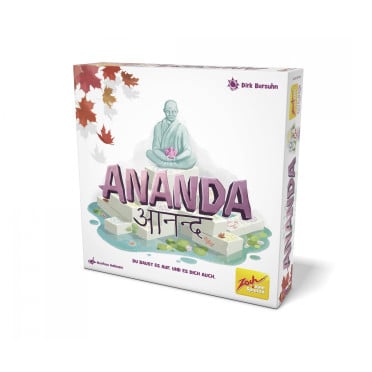Find the right balance!
Balance is the most important thing in Ananda, the balance between body and soul, meditation and work, but above all between building and getting new building blocks.In Ananda, players build a temple with domino tiles and let their monks meditate inside. The larger the colored surface built, the more karma points the player can accumulate. More precisely, at the start of his turn, a player must move his monk to a new colored area on the game board. He then plays as many tiles from his hand as he wishes, provided that at least one of the tiles is adjacent to his monk, that all the tiles placed enlarge the color zone, and that each tile precisely overlaps two tiles on the same level (tiles do not have to be on the same level to be part of the same color zone).
When you've finished placing the tiles, count the number of squares that make up the colored area to determine your area value. You can then discard any meditation cards of that color from your hand whose sum is equal to or less than that number. Next, you draw from the reserve a number of face-down tiles equal to the difference between your area value and your meditation value, your shelf being limited to a maximum of eight tiles. Finally, if you have more tiles on your shelf than cards in your hand, draw cards from your personal deck to match these numbers.
Once all the tiles have been built, the player who has scored the most karma points with the meditation cards he or she has played wins.
Contents :
- 63 building blocks
- 4 monk figurines
- 108 meditation cards
- 2 synthesis cards
- 4 storage benches
- 1 game plan
- 1 game rule
Copyright © 2025 www.philibertnet.com Legals - Privacy Policy - Cookie Preferences - Sitemap








